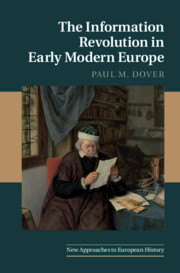Book contents
- The Information Revolution in Early Modern Europe
- New Approaches to European History
- The Information Revolution in Early Modern Europe
- Copyright page
- Dedication
- Contents
- Figures
- Acknowledgments
- 1 Introduction
- 2 European Paper
- 3 “Ink-Stained Fingers”
- 4 The Paper of Politics and the Politics of Paper
- 5 Revolutionary Print
- 6 The Book of Nature and the Books of Man
- 7 Writing Others and the Self
- 8 Conclusion
- Bibliography
- Index
5 - Revolutionary Print
Published online by Cambridge University Press: 24 September 2021
- The Information Revolution in Early Modern Europe
- New Approaches to European History
- The Information Revolution in Early Modern Europe
- Copyright page
- Dedication
- Contents
- Figures
- Acknowledgments
- 1 Introduction
- 2 European Paper
- 3 “Ink-Stained Fingers”
- 4 The Paper of Politics and the Politics of Paper
- 5 Revolutionary Print
- 6 The Book of Nature and the Books of Man
- 7 Writing Others and the Self
- 8 Conclusion
- Bibliography
- Index
Summary
In 1586, Tomaso Garzoni published a sprawling survey of the professions, La Piazza Universale di Tutte le Professioni del Mondo, e Nobili et Ignobili. His entries on dozens of professions are as much opportunities to hold forth on related questions of interest to him as they are detailed discussions of the professions themselves. In his lengthy entry on printers (stampatori), Garzoni pauses to offer a lengthy reflection on the impact of the printing press in his century. He asserts that, without the printing press and the “miraculous art of print,” much learning would remain asleep in the shadows. Print greatly reduced the “intolerable price” of books and made them accessible to many more people for whom they had been out of reach: “Today everyone can learn.”
- Type
- Chapter
- Information
- The Information Revolution in Early Modern Europe , pp. 149 - 190Publisher: Cambridge University PressPrint publication year: 2021

